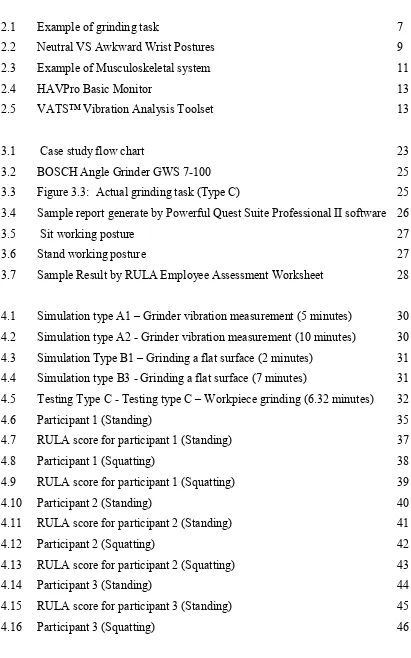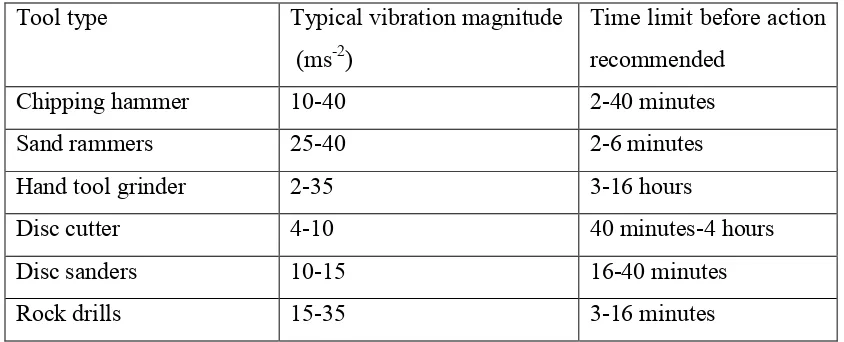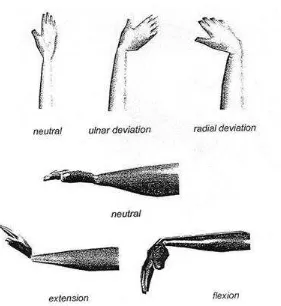DECLARATION
I hereby declare that this report entitled “Ergonomics Assessment of Grinding Task”
is the result of my own research except as cited in the references.
APPROVAL
This report is submitted to the Faculty of Manufacturing Engineering of UTeM as a partial fulfilment of the requirements for the degree of Bachelor of Manufacturing Engineering (Manufacturing Management) with Honours. The members of the supervisory committee are as follow:
ABSTRACT
ABSTRAK
DEDICATION
For my beloved parents:
For my supportive siblings
&
ACKNOWLEDGEMENT
I have received a lot of help during the process of completing my Projek Sarjana Muda (PSM). I would like to would like to take this opportunity to acknowledge their sacrifices and contribution.
First of all, I would like to give my gratefulness to the Faculty of Manufacturing Engineering of University Technical Malaysia Melaka (UTeM) for helping me in preparing formal documentation and procedures and full support in everything. I also would like to thank all PSM Committee members and also lecturers as well as FKP staffs for their help throughout this study.
TABLE OF CONTENT
2.3.1 Hand Arm Vibration Syndrome (HAVs) 9
2.3.2 Repetitive Strain Injuries (RSI) 10
2.3.3 Musculoskeletal Disorders (MSDs) 10
2.4 Musculoskeletal System 11
2.5 Method and Tools Used in Evaluating Hand Tool Ergonomics 11
2.5.2 Tools 12
2.6 Summary of Journal 17
Chapter 3 22
3.1 Planning of Study 22
3.2 Case Study Flow Chart 23
3.3 Case Study Flow Chart Explanation 24
3.4 Experiment Procedure 24
Chapter 4 29
4.1 Vibration Level 30
4.2 Working Posture 35
Chapter 5 63
5.1 Conclusion 63
5.2 Recommendations 64
REFERENCES 65
APPENDICES
A Gantt chart for PSM I B Gantt chart for PSM II
LIST OF FIGURES
2.1 Example of grinding task 7
2.2 Neutral VS Awkward Wrist Postures 9
2.3 Example of Musculoskeletal system 11
2.4 HAVPro Basic Monitor 13
2.5 VATS™ Vibration Analysis Toolset 13
3.1 Case study flow chart 23
3.2 BOSCH Angle Grinder GWS 7-100 25
3.3 Figure 3.3: Actual grinding task (Type C) 25
3.4 Sample report generate by Powerful Quest Suite Professional II software 26
3.5 Sit working posture 27
3.6 Stand working posture 27
3.7 Sample Result by RULA Employee Assessment Worksheet 28
4.1 Simulation type A1 – Grinder vibration measurement (5 minutes) 30 4.2 Simulation type A2 - Grinder vibration measurement (10 minutes) 30 4.3 Simulation Type B1 – Grinding a flat surface (2 minutes) 31 4.4 Simulation type B3 - Grinding a flat surface (7 minutes) 31 4.5 Testing Type C - Testing type C – Workpiece grinding (6.32 minutes) 32
4.6 Participant 1 (Standing) 35
4.7 RULA score for participant 1 (Standing) 37
4.8 Participant 1 (Squatting) 38
4.9 RULA score for participant 1 (Squatting) 39
4.10 Participant 2 (Standing) 40
4.11 RULA score for participant 2 (Standing) 41
4.12 Participant 2 (Squatting) 42
4.13 RULA score for participant 2 (Squatting) 43
4.14 Participant 3 (Standing) 44
4.15 RULA score for participant 3 (Standing) 45
4.17 RULA score for participant 3 (Squatting) 47
4.18 Participant 4 (Standing) 48
4.19 RULA score for participant 4 (Standing) 49
4.20 Participant 4 (Squatting) 50
4.21 RULA score for participant 4 (Squatting) 51
4.22 Participant 5 (Standing) 52
4.23 RULA score for participant 5 (Standing) 53
4.24 Participant 5 (Squatting) 54
4.25 RULA score for participant 5 (Squatting) 55
4.26 Participant 6 (Standing) 56
4.27 RULA score for participant 6 (Standing) 57
4.28 Participant 6 (Squatting) 58
4.29 RULA score for participant 6 (Squatting) 59
LIST OF TABLES
4.25 Working posture risk assessment for group B for participant 6 (Squatting) 59
4.26 Working posture risk assessment score 60
4.27 Working posture risk assessment score frequency 60
LIST OF ABBREVIATIONS
FKP - Fakulti Kejuruteraan Pembuatan
HAVS - Hand Arm Vibration Syndrome
MSDs - Musculoskeletal Disorders
PSM - Projek Sarjana Muda
REBA - Rapid Entire Body Assessment
RMS - Root Mean Square
RSI - Repetitive Strain Injuries
RULA - Rapid Upper Limb Assessment
CHAPTER 1
INTRODUCTION
This chapter explains the background of the case study, objective, scope, problem statement and the potential benefit of this study. The basic fundamental of grinding task, vibration and working posture will be discussed in background of study. Problem statement will discover why this research carried out. The objective and potential benefit of this research will be highlighted at the end of this chapter.
1.1 Background of study
Now a day, workers always exposed to safety and health problems. They can have injured by environment, machine and tools their use anytime and everywhere. So that, all organization or company concern about worker safety and health. The healthiness of worker gives effect for their productivity and performance and at the same time it will effect also company production. Until now, many experiment and case study conduct to make analysis about worker health and safety in working environment. Furthermore, workers now are protected by laws and labor society.
There are many methods used to ensure the workers safety and health guaranteed. One popular way is to use ergonomic analysis. Ergonomics is a word that means the science of work and a person’s relationship to that work. In engineering term, ergonomics is the scientific discipline concerned with the understanding of interactions among humans and other elements of a system, and the profession that applies theory, principles, data and methods to design in order to optimize human well being and overall system performance. Ergonomists contribute to the design and evaluation of tasks, jobs, products, environments and systems in order to make them compatible with the needs, abilities and limitations of people.
Grinding process is example tasks that possible give bad side effect to worker. Normally, grinders used with abrasive cutting tools to bring a workpiece to an accurate size and produce a good high surface finish. In grinding process, the surface work is brought into contact with the revolving grinding wheel. The grinding machine consists of a power driven grinding wheel spinning at the required speed. This revolving wheel is produced by motor and its produce vibration. By get certain frequencies and levels of vibration can permanently damage internal body organ and white fingers syndrome.
Besides vibration, technique during doing task also possible give affect to worker healthy. Bad posture can cause musculoskeletal pain and even disability. Musculoskeletal pain is pain that affects the muscles, ligaments and tendons, along with the bones. Symptoms that might be felt include back and neck pains, headache, fatigue and, potentially, even breathing issues. In extreme cases bad posture can even lead to internal organ damage by restricting the blood supply to these areas.
1.2 Problem Statement
There are no any guide or reference that worker can use to avoid this problem. Furthermore, some of the side effects from grinding task not appear immediately. So, worker not realized that they have health problem. Maybe, it’s late to overcome the health problem when is appear.
1.3 Objective of Study
The objectives of this study are:
(a) To evaluate the level of vibration in a simulated grinding task; (b) To conduct a postural analysis in a simulated grinding task; (c) To recommend a proper way for grinding task to reduce risk.
1.4 Scope of Study
This study about the effect on human by hand tools grinder during grinding task. The research only focus on working posture during grinding task and the level of vibration produce by the grinding task. There are many type of grinder but for this study grinder brand BOSCH GWS 7-100 will be used. The subject of experiment is FKP student and the testing place at FKP workshop.
1.5 Potentials Benefits
1.6 Outline of Report
Generally, PSM 1 report is divided into three chapters. The first chapter is the introduction of the report. It discusses about the background of study, problem statement, scope, objective and case study potential benefit.
Chapter two is the literature review which will do based on journal, books, internet resources and previous studies done on the related topic. This chapter will discuss about overview of grinding task, grinding task effect on human and methods and tools used in evaluating hand tool ergonomics. The discussion is based on information gathered.
CHAPTER 2
LITERATURE REVIEW
This chapter contains the literature review of the study which related to scope of the study. It covers the important elements in this case study such as definition and work study that can be use in this study. The sources of information are obtained from articles, journal, case study, report and also electronics resources. At the end of this chapter, the entire element will be narrowed down to the scope of study.
2.1 Introduction
Integration of human aspects into the technological planning processes in a company is a major strategy for the prevention of work-related injuries and illnesses among employees in manufacturing facilities (Ole Broberg, 1997). The method that used to relate human and work related injuries is by ergonomics. Ergonomics is the theoretical and fundamental understanding of human behavior and performance in purposeful interacting socio technical systems, and the application of that understanding to design of interactions in the context of real settings (John R. Wilson, 2000).Ergonomics includes information from engineering, biomechanics, environmental psychology, physiology and other fields about how human beings are affected by their environment, especially in the workplace. The main focus of ergonomic is to improve safety, productivity, and quality of life.
physical, physiological, biomechanical, and psychological capabilities, and optimizing the effectiveness and productivity of work systems while assuring the safety, health, and wellbeing of the workers. In general, the aim in ergonomics is to fit the task to the individual, not the individual to the task.
In ergonomics, there are two categories which are referred to as industrial ergonomics and human factor. Industrial ergonomics focus on physical aspects of work and human capabilities such as force, posture and repetition work. Human factor is focus to the psychological aspects of work such as mental loading and decision making. Based on the definition, an ergonomist evaluates the demands of a specific task with reference to the capacity of workers to perform the task over a certain time period.The necessity of understanding physiological causes of occupational injuries is growing now that more safety issues and ergonomics intervention programs are imposed by work regulations (Issachar Gilad, 1994). So that, Ergonomic study and research doing for:
(a) Select tools for ergonomic reasons as well as vibration and other factors (b) Create guidelines for correct tool selection and use on each type of operation (c) Ensure operators are properly trained and understand the reasons for correct use
2.2 Overview of Grinding Task
Figure 2.1: Example of grinding task
Sources: http://images.toolstop.co.uk/product/BOS-GWS18v-li-1.jpg
2.3 Grinding Task Effect on Human
Physical exposure has three main dimensions to human body by amplitude (load level), repetition and duration. Human can get health problem cause by two conditions which are vibration and awkward posture.
(a) Vibration
Vibration is the mechanical oscillations of an object about an equilibrium point. The oscillations may be regular such as the motion of a pendulum or random. The study of health effects of vibration require measures of the overall "pressure waves" that are generated by vibrating equipment or structure. Vibration can be transmitted to the human body by vibrating surfaces of vehicles, machines, structures in contact with the human body.
When a worker operates hand tool such as a grinder or jackhammer, vibration affects hands and arms. Clinical and epidemiological studies have shown that operators of hand held power tools are prone to develop various vibration induced disorders of the hand and arm, which are collectively referred as hand arm vibration syndrome(HAVS) (S.Rakheja et al, 2010) The level of hand arm vibration is determined by measuring the acceleration of the tools or object grasped by worker.
Table 2.1: Hand tools vibration level Sources: www.hse.gov.uk/pubns/misc112.pdf
Tool type Typical vibration magnitude
(ms-2)
Time limit before action recommended
Chipping hammer 10-40 2-40 minutes
Sand rammers 25-40 2-6 minutes
Hand tool grinder 2-35 3-16 hours
Disc cutter 4-10 40 minutes-4 hours
Disc sanders 10-15 16-40 minutes
Rock drills 15-35 3-16 minutes
(b) Awkward posture
Awkward postures refer to positions of the body (limbs, joints, back) that contrast from the neutral position while job tasks are being performed. Awkward postures occur when joints are not in neutral positions. Awkward postures often are contributors to musculoskeletal disorders (MSDs) because they increase the work and the muscle force that is required. When working in awkward postures, it will increase the amount of force need to accomplish the task.
turn, the more force is needed to complete the task. Thus, awkward postures make forceful exertions even more forceful, from the standpoint of the muscle, and increase the amount of recovery time that is needed.
Figure 2.2: Neutral vs. Awkward Wrist Postures Source: http://www.goer.state.ny.us/ergo/wrist-postures.cfm
2.3.1 Hand Arm Vibration Syndrome (HAVS)
Hand–arm vibration syndrome (HAVS) is the term often used for the symptoms associated with prolonged occupational exposure to hand–arm vibration arising from operation of hand-held power tools (Y. Aldien et al, 2006).Hand-arm vibration syndrome is often reported by workers that are exposed to Hand-arm vibration (HAV) generated from using handheld tools (Barregard et al., 2003).


